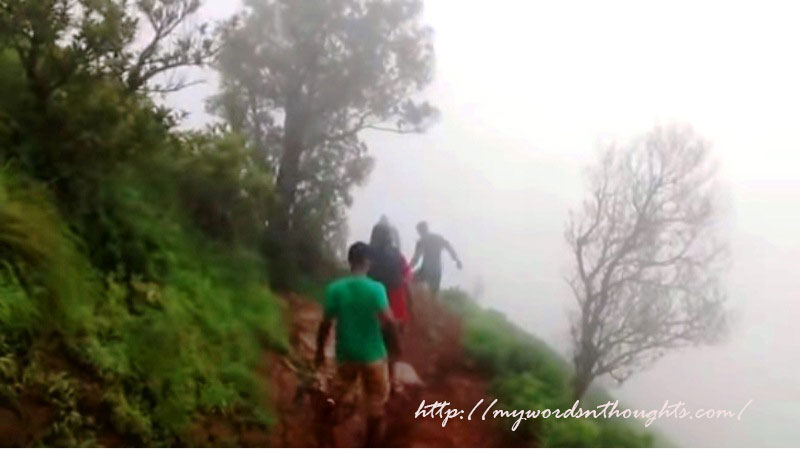A holy trip to Kudajadri (Kodachadri) hills of Karnataka
When you offer prayers at Kollur Mukambika temple in the morning, Kodachadri hills are visible at the distance. Above the greenery of Amba forests, white mist is drawing beautiful pictures. It’s somewhere in the forests, where Adi Shankara meditated and prayed to god. It’s believed that a devotee travels to Mookambika only if the goddess calls. The journey to deep blue Kudajadri too is similar. The call of mountain ranges which hides the footsteps of Adi Shankara prompts the devotee to travel to the hill ranges, though he has to face a lot of difficulties. Kudajadri is also pronounced as Kodachadri in Kannada language. It’s also nicknamed as ‘Jasmine of the hills’.

Sarvajna Peeta is at the peak of Kodachadri
Kollur Mukambika temple is situated somewhere in the deep silent valleys of Kudajadri. Is it the reason why temple premises hold some kind of divinity, spirituality, calmness and silence? Till now the developments which conquered the whole world has not affected the site so much. Yet plastic wastes are common in Sauparnika River and on its banks. Yet the river offers calmness and coolness to the devotees.
Lotus buds, jasmine garlands, camphor and coconuts – devotees place these items in a plate and offer it to goddess. In the temple premises and on the roads leading to the temples, shops are available selling these items. There is one female elephant in the temple named Indira which blesses the devotees. Kodajadri hill is about 38 kms from Kollur temple, and if you are ready for an adventurous trip get ready for it.
Through the greenery of Mookambika forests
The temple and premises are crowded during Navaratri blessings. If you want a silent trip to Kodachadri, choose an off-season. The path will be silent and desolated, which is a part of Mukambika reserve forest. You can take the path through Nagodi to reach Kodachadri. The path is filled with the spectacular beauty of green forests. Dry forests are also seen occasionally. The hills are filled with Kudaja flowers, and the mountain is named after Kudaja flowers, which resemble jasmine flowers. Kudajadri means Adri (mountain) of Kudaja flowers.

A jeep trip to Kudajadri hills
When you reach Kaaran Kattai, there is a side path which leads towards deep forests. It is the short path which leads to Kudajadri hills. If you are interested in an adventurous trip or trekking, you can choose this forest path to climb the hills. You need to walk 12 kms through forests to reach the base of Kudajadri hills. At Nittoor jeeps are available which carry tourists to destination. At Kattina Holle, the tar road ends. Yet you can continue the journey through stone path. A check post is available and only jeeps can travel through the difficult path. Only an expert driver can drive jeeps easily through this path. Though it’s only 10 km distant, the path is not so easy.
During Navaratri seasons, approximate 260 jeeps pass through this road. As the roads are not smooth, engines of jeeps get damaged easily. Stones, rocks and root of trees on paths, along with curves and hairpins make your journey difficult. Hence precautions are to be taken while driving jeeps and bikes through these roads. Many often youngsters neglect such warnings. Except elephants, all wild animals are found in these forests. Jeep safari is not recommended for infants, old people and those with weak hearts.
Stories which sleep in the mountain valleys of Kudajadri
Trekking ends at Marankattai valley, a flat piece of land. It’s the base and starting point which leads towards the mountain ranges. It’s the same point where the forest path ends (the path which starts from Kaaran Kattai). An iron rod similar to a Shoolam is visible in this valley, which is of good height. Still it’s an unsolved puzzle, who fixed it here. Already many researches have been conducted about this iron rod. This place gets good rainfall. Yet you may wonder why this iron rod hasn’t rust till now. Does it have any other building material? Really an unsolved puzzle! As per popular belief, Devi after killing Mookasura, she fixed her shoolam here. Hence it’s also believed that this place is the moola sthanam (place of origin) of Devi Mookambika temple.

Temples at the base of Kodajadri hills
In the lower premises of Marankattai there are deities of Kalabhairava and Moola Mookambika. Non-brahmins conduct pooja rituals here. Hen sacrifices are conducted here after sun set, and it’s known by the name, Shaaktheya Pooja. Devotees can do this pooja as offerings to the deities. There are two temples in the upper side of Marankattai too – Bhadrakali temple and Parvathy-Parameshwara temple. Stone idols of Shiva and Parvathy are worshipped here. Camphor and flowers are offered, and lamps are also lighted. Devotees can offer poojas and directly worship the deities.
Only Sathvika pooja (good rituals) are conducted here. Before pilgrims climb the Kudajadri temple, they offer poojas at this small temple. They also circumnavigate the temples. There is one big holy pond near to the temple, which is believed to be filled with water with medicinal qualities. Linganamakki Dam and its premises are seen at distance. Traveller’s bungalow is also seen in the valleys, where pilgrims can stay at night.
Journey that leads to Ganapati cave
From this point, the journey to Kudajadri hills begins. The hills start with shrubs and rocks. Sparse forests later lead to dense forests. Stones of these forests are slightly heavy because of the presence of Manganese. Though many people tried for illegal mining in this place, it’s only because of the resistance by nature lovers and local people, this place still stays close to nature without any destruction. Kudajadri hills hold a feel of sacredness. Thanks to them.
One has to take footsteps, and remove climbers and shrubs from the path to scale the mountain. Shrubs are seen here and there. For some people Kodachadri is a picnic spot. People love to take photos using mobile phones and cameras. At least a few tourists forget the fact that it is a pilgrim spot.
You can see Sarvajna Peedam from distance, our destination point. When you travel two kilometres, in the forest there is a sign board pointing Ganapati cave. From that point, take right diversion and travel a little through forest path to reach the place. There is a Ganesa idol installed here, and pooja materials are placed in a plate. There is one priest too, who is willing to do poojas for you, if asked. The people who sit inside the cave are not real priests or saints. Most of them are devotees, who make these poojas a source of earning. When tourists pass by, they offer poojas and also give a small amount to the person who conducts it.
There is a tunnel near the cave. Darkness fills the whole space inside. It’s not easy to travel through the cave for long distance, because of the shortage of oxygen. As per legends this tunnel leads to Amba forests and Chitramoola cave.
Sarvajna Peedam (Sarvajna Peeta)

People taking stone path to reach Sarvajna Peeta, Kodachadri
When you pass the cave and ascend the mountains, you reach a flat place similar to a plateau. You are welcomed by shrubs and climbers throughout the path, which leads to this point. You can take a deep breath and watch surrounding mountain ranges, a little more close. The paths are filled with tall grass, and small hills without trees are also visible. On left side there is a deep valley.
When you travel ¾ km from Ganapati cave, Sarvajna Peedam situated in the mountain ranges is seen from distance. Adi Shankara’s idol is installed here. Lamps are lighted and poojas are also conducted by priests. Earier, it was a stone mandapam only. Adi Shankara’s idol was installed just 18 years ago. Just like the priests of Ganapati cave, priests arrive this place in the early mornings from home and leave the space in the evenings, and they travel by foot to reach this place.
As per legends Adi Shankara climbed Sarvajna Peedam and meditated here. It’s quite common to see tourists meditate in the deep silence of this sacred place. The place is so lonely with deep valleys beneath. Green forests touch the skies, and Mookambika temple appears at distance as a spot from the mountain top. When sky is clear deep blue of Arabian seas is visible at the west as a thin line too.

There are many people who write their names in the stones, and interestingly it stays so after many years. How many tourists and pilgrims might have visited this place till now! How many lovers and how many people who love adventurous trips! Though when you start the trip you have the intension to conquer the mountain top, when you finally reach the destination, you feel yourself as a very silly person in the whole world. Leave behind that ego, envy and pride, and fill your mind with eternal happiness. This place is the best spot to get this unique experience.
Wonders of Chitramoola
Now we have entered the most difficult phase of our journey – the journey to reach Chitramoola cave. This cave is situated in the lower side of this big mountain and looks as if a big rock has split into two to form a cave. It’s a steep cut to travel downwards to reach this cave, and hence is adventurous. One has to alight through forest paths, which are not clearly drawn. In most cases people end their journey at Sarvajna Peedam and alight the mountain through the path they traversed before. Only a few people try to reach Chitramoola, and it’s not possible for all.

Beliefs and devotion towards goddess are two main points, which guide people to reach Chitramoola, taking a risky path, sometimes risking their own lives as well. The traveller needs to be an expert in trekking to take this risk easily. He needs to crawl sometimes through rocks, wild trees and creepers, and fix their hands on rocks to descend down through the steep path. When you descend the steep rocks, you might wonder if it is possible to climb the rocks upwards. (After visiting the holy cave, traveller needs to climb to reach Sarvajna Peedam before he can descend the mountains). When you reach the final destination, it gives you a unique feel.
The cave is visible from a little distance, and slightly in an elevated position. There is a wooden ladder to climb the caves. But now it’s almost in a damaged stage. So the visitors need to make use of ropes to enter the cave. There is a Siva idol installed inside the cave. There is a small fresh water stream in the upper side of cave. As per popular beliefs, the water of this stream has medicinal value. When tired devotees and travellers reach this cave, they quench their thirst from the stream, which also helps them to get rid of tiredness.

There is a spiritual feel inside the cave, a feel of loneliness and mystery too. Amba forest is in its intense mood in the surroundings of the cave. Greenery also grants a pleasing appeal. As per beliefs, Sri Shankara meditated in this cave, and it’s exactly the same place where goddess appeared before him and blessed him. Shankara wanted to install a temple dedicated to goddess in his birthplace Kalady. When he expressed his desire to the goddess, she agreed, but on one condition that he should never turn back till he reach the destination. If he turns back before reaching there, she will stop the journey there, and he will have to install her idol there. When both reached Kollur, Shankara couldn’t hear the voice of anklets, and in curiosity and doubt he turned back. She was visible at a little distance. As agreed, Shankara had to install her in this position. That’s the story behind the world famous Mookambika temple which is located on the banks of Sauparnika river.

Water stream inside Chitramoola cave
Even if it has not happened, there were many symbols which clearly indicated the divinity of the place, and nature itself provided everything for the installation of Devi’s idol there. It was the perfect place for goddess to reside, long before Shankara met Goddess, and through him, it happened in an order of events. It’s nothing short of destiny. It was already destined that goddess is to reside in that mountain valley. Devi killed Mahishasura and Mookasura before this incident exactly at the same place. Also Trimurthi installed their divinity in the place through Sree Chakram (sacred wheel) before Adi Shankara incident.
Yet as requested by Adi Shankara, she agreed to reside in Chottanikara devi temple also. Now also Mookambika temple opens only after the morning pooja of Chottanikara temple. It’s believed that the time difference between the morning poojas of both these temples is the time needed by goddess to reach Kollur from Chottanikara. As per popular belief, goddess stays in Chottanikara during early dawn prayers, and later travel to Kollur before morning prayers at this temple begins. Chottanikara Devi has three figures – Saraswati, Mahalakshmi and Durga, and hence worshipped in all these three forms in the temple.
Return trip
The traveller has to climb the mountain from the cave to reach Sarvajna Peedam, and it’s not so easy. Travellers come in folk at Sarvajna Peedam, where they stay for some time, take rest and even meditate. As sun is getting ready to set, darkness slowly swallows the mountain ranges. The spaces once again turn lonely, as travellers most probably walk down before sun sets. At dusk Sarvajna Peedam and Ganapati caves become isolated and lonely places.
Sunset at Kudajadri is a beautiful sight to watch. The night at Kudajadri is more beautiful. Same is the case of sunrise. There are many people who stay at Travellers’ Bungalow overnight and climb the mountains at dawn.
How to reach Kudajadri (Kodachadri) hills of Karnataka?

Misty mountains and valleys of Kudajadri
Kudajadri is located in Shimoga district of Karnataka. As per legends Adi Shankara prayed to goddess in Kudajadri hills, which forms a part of Sahya mountain ranges. The place which is at 4406 feet height is believed to have the divinity of Goddess and hence considered a holy place. It’s around 42 kms between Kollur and Kudajadri. From Kollur to the valleys of Kudajadri jeep service is available. From there, a traveller needs to walk on foot to reach Sarvajna Peedam. A traveller can reach Kollur through Mangalore which is 140 kms away.

Kollur Mookambika Temple
Also read a few more articles on tourist locations outside Kerala. Click on the images in the gallery to read

















Recent Comments